Structure and Function of the Respiratory System
VerifiedAdded on 2023/04/21
|19
|3797
|442
AI Summary
This document provides an in-depth understanding of the structure and function of the respiratory system, including the organs involved in breathing and the process of gas exchange. It also discusses the conditions necessary for effective gaseous exchange. Additionally, it covers the components of blood plasma, the structure and function of red blood cells, and the process of carrying oxygen and carbon dioxide in the blood. Furthermore, it explores the structure and function of arteries, veins, capillaries, and the heart.
Contribute Materials
Your contribution can guide someone’s learning journey. Share your
documents today.
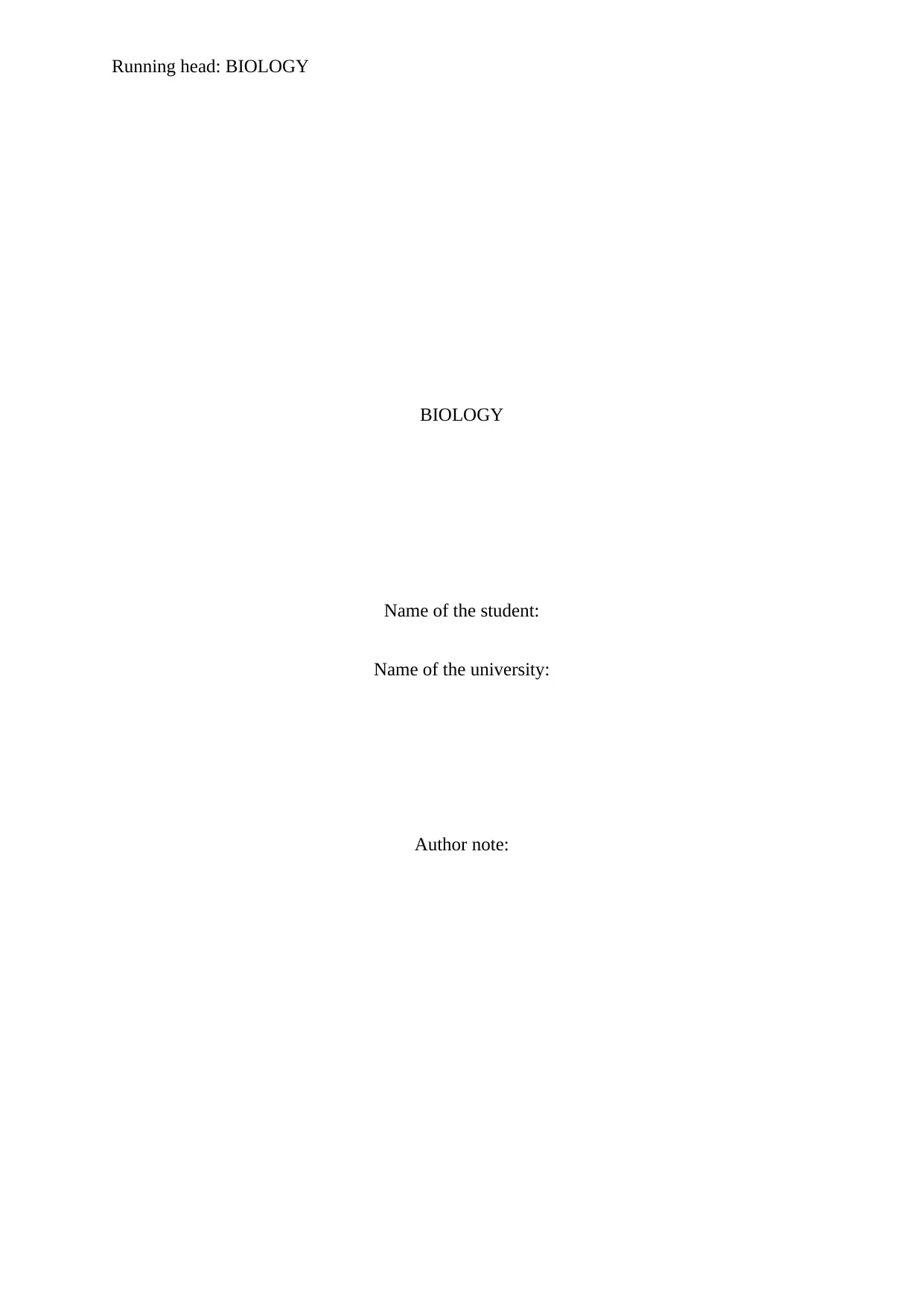
Running head: BIOLOGY
BIOLOGY
Name of the student:
Name of the university:
Author note:
BIOLOGY
Name of the student:
Name of the university:
Author note:
Secure Best Marks with AI Grader
Need help grading? Try our AI Grader for instant feedback on your assignments.
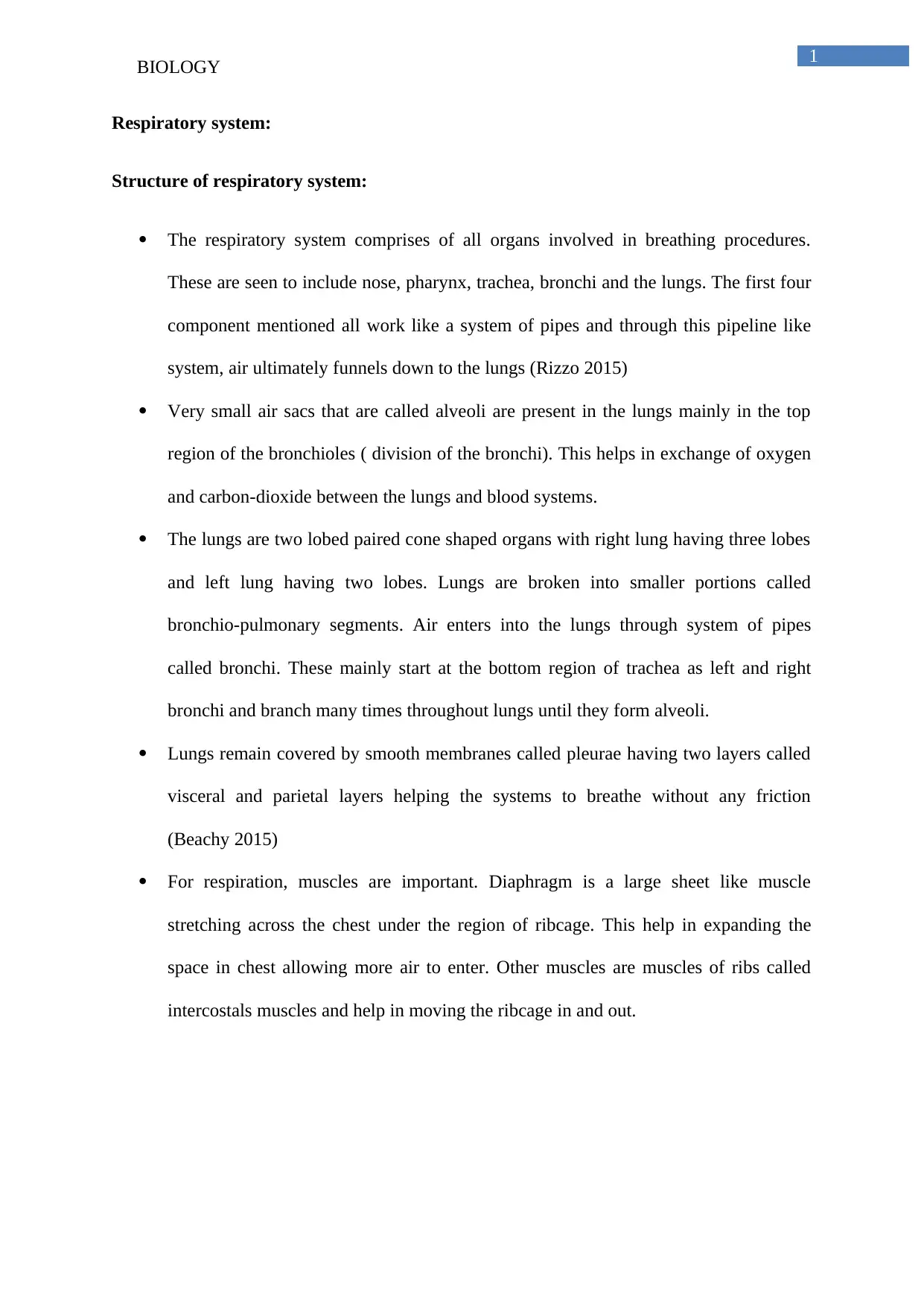
1
BIOLOGY
Respiratory system:
Structure of respiratory system:
The respiratory system comprises of all organs involved in breathing procedures.
These are seen to include nose, pharynx, trachea, bronchi and the lungs. The first four
component mentioned all work like a system of pipes and through this pipeline like
system, air ultimately funnels down to the lungs (Rizzo 2015)
Very small air sacs that are called alveoli are present in the lungs mainly in the top
region of the bronchioles ( division of the bronchi). This helps in exchange of oxygen
and carbon-dioxide between the lungs and blood systems.
The lungs are two lobed paired cone shaped organs with right lung having three lobes
and left lung having two lobes. Lungs are broken into smaller portions called
bronchio-pulmonary segments. Air enters into the lungs through system of pipes
called bronchi. These mainly start at the bottom region of trachea as left and right
bronchi and branch many times throughout lungs until they form alveoli.
Lungs remain covered by smooth membranes called pleurae having two layers called
visceral and parietal layers helping the systems to breathe without any friction
(Beachy 2015)
For respiration, muscles are important. Diaphragm is a large sheet like muscle
stretching across the chest under the region of ribcage. This help in expanding the
space in chest allowing more air to enter. Other muscles are muscles of ribs called
intercostals muscles and help in moving the ribcage in and out.
BIOLOGY
Respiratory system:
Structure of respiratory system:
The respiratory system comprises of all organs involved in breathing procedures.
These are seen to include nose, pharynx, trachea, bronchi and the lungs. The first four
component mentioned all work like a system of pipes and through this pipeline like
system, air ultimately funnels down to the lungs (Rizzo 2015)
Very small air sacs that are called alveoli are present in the lungs mainly in the top
region of the bronchioles ( division of the bronchi). This helps in exchange of oxygen
and carbon-dioxide between the lungs and blood systems.
The lungs are two lobed paired cone shaped organs with right lung having three lobes
and left lung having two lobes. Lungs are broken into smaller portions called
bronchio-pulmonary segments. Air enters into the lungs through system of pipes
called bronchi. These mainly start at the bottom region of trachea as left and right
bronchi and branch many times throughout lungs until they form alveoli.
Lungs remain covered by smooth membranes called pleurae having two layers called
visceral and parietal layers helping the systems to breathe without any friction
(Beachy 2015)
For respiration, muscles are important. Diaphragm is a large sheet like muscle
stretching across the chest under the region of ribcage. This help in expanding the
space in chest allowing more air to enter. Other muscles are muscles of ribs called
intercostals muscles and help in moving the ribcage in and out.

2
BIOLOGY
Fig: structure of respiratory system: Source: (Beachy 2015)
Fig: structure of respiratory system: diaphragm; Source: (Protti et al. 2015)
BIOLOGY
Fig: structure of respiratory system: Source: (Beachy 2015)
Fig: structure of respiratory system: diaphragm; Source: (Protti et al. 2015)
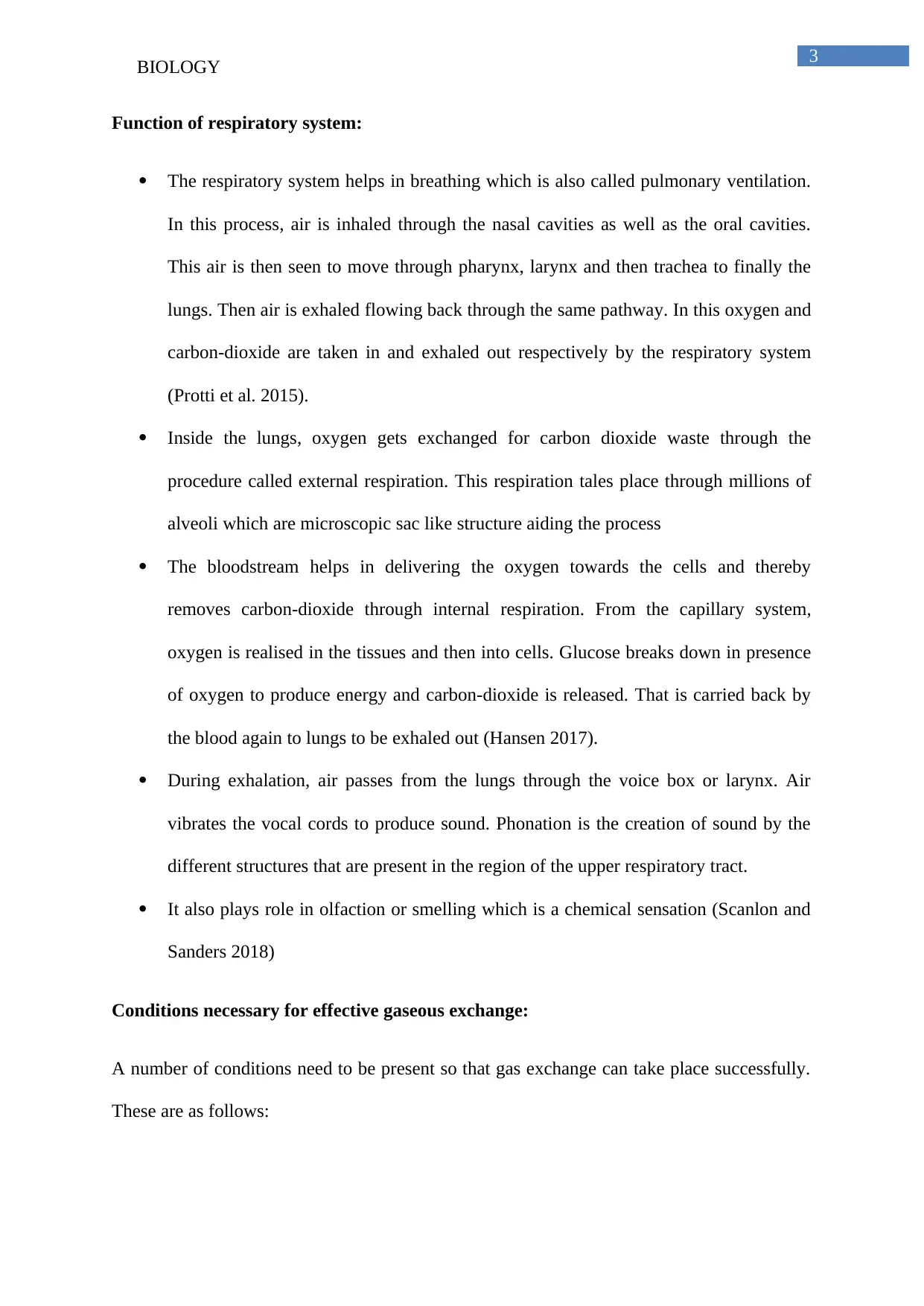
3
BIOLOGY
Function of respiratory system:
The respiratory system helps in breathing which is also called pulmonary ventilation.
In this process, air is inhaled through the nasal cavities as well as the oral cavities.
This air is then seen to move through pharynx, larynx and then trachea to finally the
lungs. Then air is exhaled flowing back through the same pathway. In this oxygen and
carbon-dioxide are taken in and exhaled out respectively by the respiratory system
(Protti et al. 2015).
Inside the lungs, oxygen gets exchanged for carbon dioxide waste through the
procedure called external respiration. This respiration tales place through millions of
alveoli which are microscopic sac like structure aiding the process
The bloodstream helps in delivering the oxygen towards the cells and thereby
removes carbon-dioxide through internal respiration. From the capillary system,
oxygen is realised in the tissues and then into cells. Glucose breaks down in presence
of oxygen to produce energy and carbon-dioxide is released. That is carried back by
the blood again to lungs to be exhaled out (Hansen 2017).
During exhalation, air passes from the lungs through the voice box or larynx. Air
vibrates the vocal cords to produce sound. Phonation is the creation of sound by the
different structures that are present in the region of the upper respiratory tract.
It also plays role in olfaction or smelling which is a chemical sensation (Scanlon and
Sanders 2018)
Conditions necessary for effective gaseous exchange:
A number of conditions need to be present so that gas exchange can take place successfully.
These are as follows:
BIOLOGY
Function of respiratory system:
The respiratory system helps in breathing which is also called pulmonary ventilation.
In this process, air is inhaled through the nasal cavities as well as the oral cavities.
This air is then seen to move through pharynx, larynx and then trachea to finally the
lungs. Then air is exhaled flowing back through the same pathway. In this oxygen and
carbon-dioxide are taken in and exhaled out respectively by the respiratory system
(Protti et al. 2015).
Inside the lungs, oxygen gets exchanged for carbon dioxide waste through the
procedure called external respiration. This respiration tales place through millions of
alveoli which are microscopic sac like structure aiding the process
The bloodstream helps in delivering the oxygen towards the cells and thereby
removes carbon-dioxide through internal respiration. From the capillary system,
oxygen is realised in the tissues and then into cells. Glucose breaks down in presence
of oxygen to produce energy and carbon-dioxide is released. That is carried back by
the blood again to lungs to be exhaled out (Hansen 2017).
During exhalation, air passes from the lungs through the voice box or larynx. Air
vibrates the vocal cords to produce sound. Phonation is the creation of sound by the
different structures that are present in the region of the upper respiratory tract.
It also plays role in olfaction or smelling which is a chemical sensation (Scanlon and
Sanders 2018)
Conditions necessary for effective gaseous exchange:
A number of conditions need to be present so that gas exchange can take place successfully.
These are as follows:
Secure Best Marks with AI Grader
Need help grading? Try our AI Grader for instant feedback on your assignments.
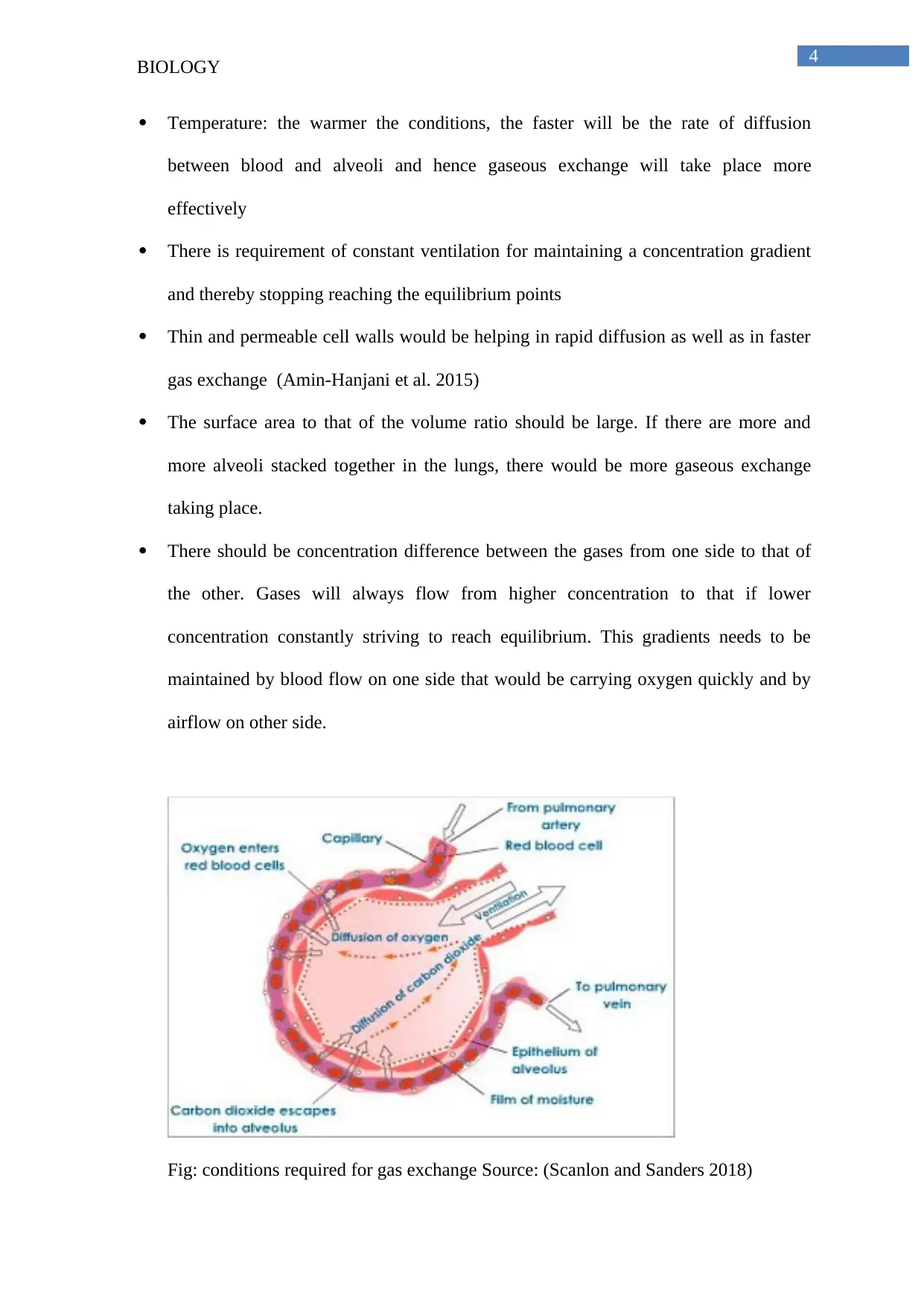
4
BIOLOGY
Temperature: the warmer the conditions, the faster will be the rate of diffusion
between blood and alveoli and hence gaseous exchange will take place more
effectively
There is requirement of constant ventilation for maintaining a concentration gradient
and thereby stopping reaching the equilibrium points
Thin and permeable cell walls would be helping in rapid diffusion as well as in faster
gas exchange (Amin-Hanjani et al. 2015)
The surface area to that of the volume ratio should be large. If there are more and
more alveoli stacked together in the lungs, there would be more gaseous exchange
taking place.
There should be concentration difference between the gases from one side to that of
the other. Gases will always flow from higher concentration to that if lower
concentration constantly striving to reach equilibrium. This gradients needs to be
maintained by blood flow on one side that would be carrying oxygen quickly and by
airflow on other side.
Fig: conditions required for gas exchange Source: (Scanlon and Sanders 2018)
BIOLOGY
Temperature: the warmer the conditions, the faster will be the rate of diffusion
between blood and alveoli and hence gaseous exchange will take place more
effectively
There is requirement of constant ventilation for maintaining a concentration gradient
and thereby stopping reaching the equilibrium points
Thin and permeable cell walls would be helping in rapid diffusion as well as in faster
gas exchange (Amin-Hanjani et al. 2015)
The surface area to that of the volume ratio should be large. If there are more and
more alveoli stacked together in the lungs, there would be more gaseous exchange
taking place.
There should be concentration difference between the gases from one side to that of
the other. Gases will always flow from higher concentration to that if lower
concentration constantly striving to reach equilibrium. This gradients needs to be
maintained by blood flow on one side that would be carrying oxygen quickly and by
airflow on other side.
Fig: conditions required for gas exchange Source: (Scanlon and Sanders 2018)
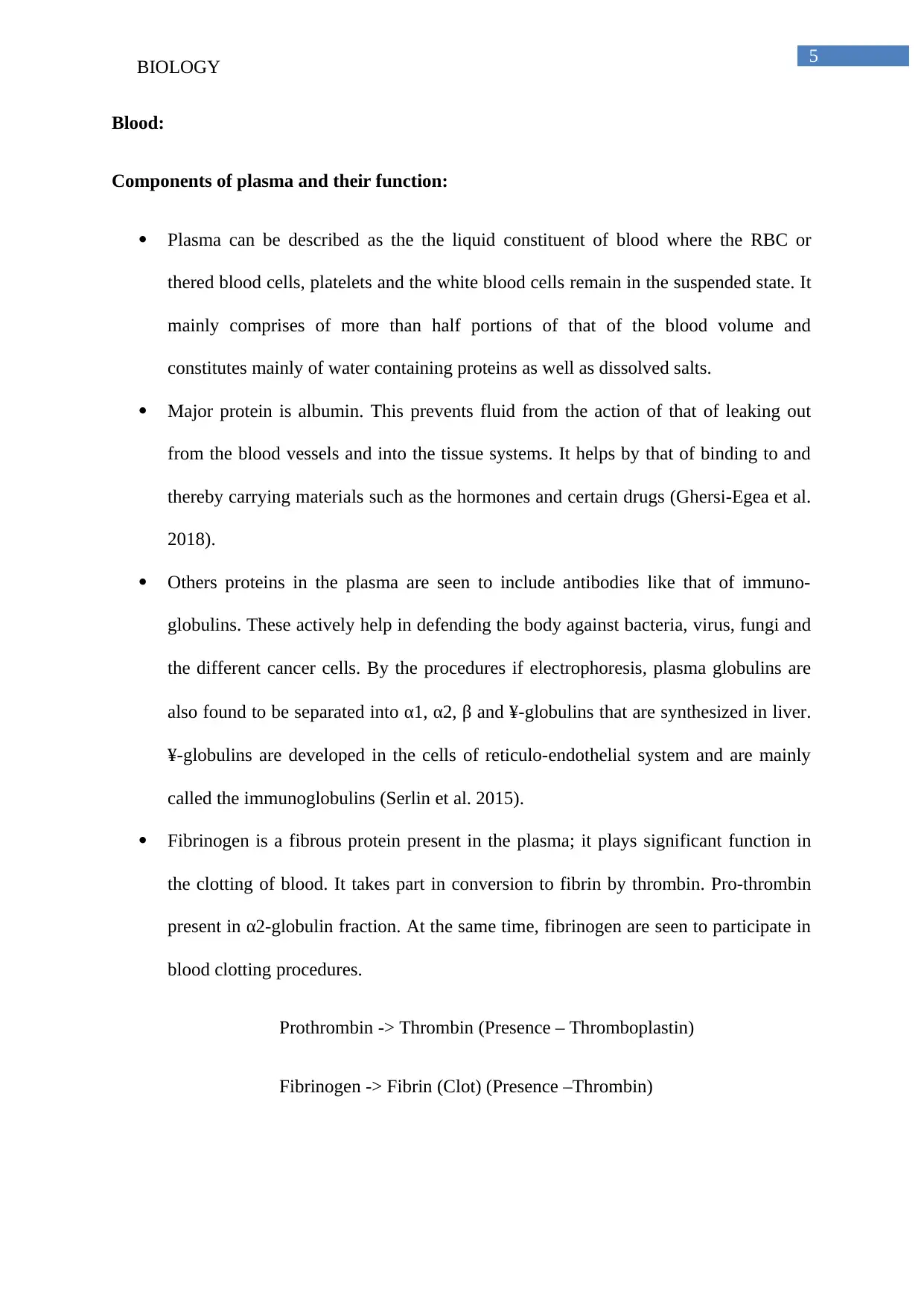
5
BIOLOGY
Blood:
Components of plasma and their function:
Plasma can be described as the the liquid constituent of blood where the RBC or
thered blood cells, platelets and the white blood cells remain in the suspended state. It
mainly comprises of more than half portions of that of the blood volume and
constitutes mainly of water containing proteins as well as dissolved salts.
Major protein is albumin. This prevents fluid from the action of that of leaking out
from the blood vessels and into the tissue systems. It helps by that of binding to and
thereby carrying materials such as the hormones and certain drugs (Ghersi-Egea et al.
2018).
Others proteins in the plasma are seen to include antibodies like that of immuno-
globulins. These actively help in defending the body against bacteria, virus, fungi and
the different cancer cells. By the procedures if electrophoresis, plasma globulins are
also found to be separated into α1, α2, β and ¥-globulins that are synthesized in liver.
¥-globulins are developed in the cells of reticulo-endothelial system and are mainly
called the immunoglobulins (Serlin et al. 2015).
Fibrinogen is a fibrous protein present in the plasma; it plays significant function in
the clotting of blood. It takes part in conversion to fibrin by thrombin. Pro-thrombin
present in α2-globulin fraction. At the same time, fibrinogen are seen to participate in
blood clotting procedures.
Prothrombin -> Thrombin (Presence – Thromboplastin)
Fibrinogen -> Fibrin (Clot) (Presence –Thrombin)
BIOLOGY
Blood:
Components of plasma and their function:
Plasma can be described as the the liquid constituent of blood where the RBC or
thered blood cells, platelets and the white blood cells remain in the suspended state. It
mainly comprises of more than half portions of that of the blood volume and
constitutes mainly of water containing proteins as well as dissolved salts.
Major protein is albumin. This prevents fluid from the action of that of leaking out
from the blood vessels and into the tissue systems. It helps by that of binding to and
thereby carrying materials such as the hormones and certain drugs (Ghersi-Egea et al.
2018).
Others proteins in the plasma are seen to include antibodies like that of immuno-
globulins. These actively help in defending the body against bacteria, virus, fungi and
the different cancer cells. By the procedures if electrophoresis, plasma globulins are
also found to be separated into α1, α2, β and ¥-globulins that are synthesized in liver.
¥-globulins are developed in the cells of reticulo-endothelial system and are mainly
called the immunoglobulins (Serlin et al. 2015).
Fibrinogen is a fibrous protein present in the plasma; it plays significant function in
the clotting of blood. It takes part in conversion to fibrin by thrombin. Pro-thrombin
present in α2-globulin fraction. At the same time, fibrinogen are seen to participate in
blood clotting procedures.
Prothrombin -> Thrombin (Presence – Thromboplastin)
Fibrinogen -> Fibrin (Clot) (Presence –Thrombin)
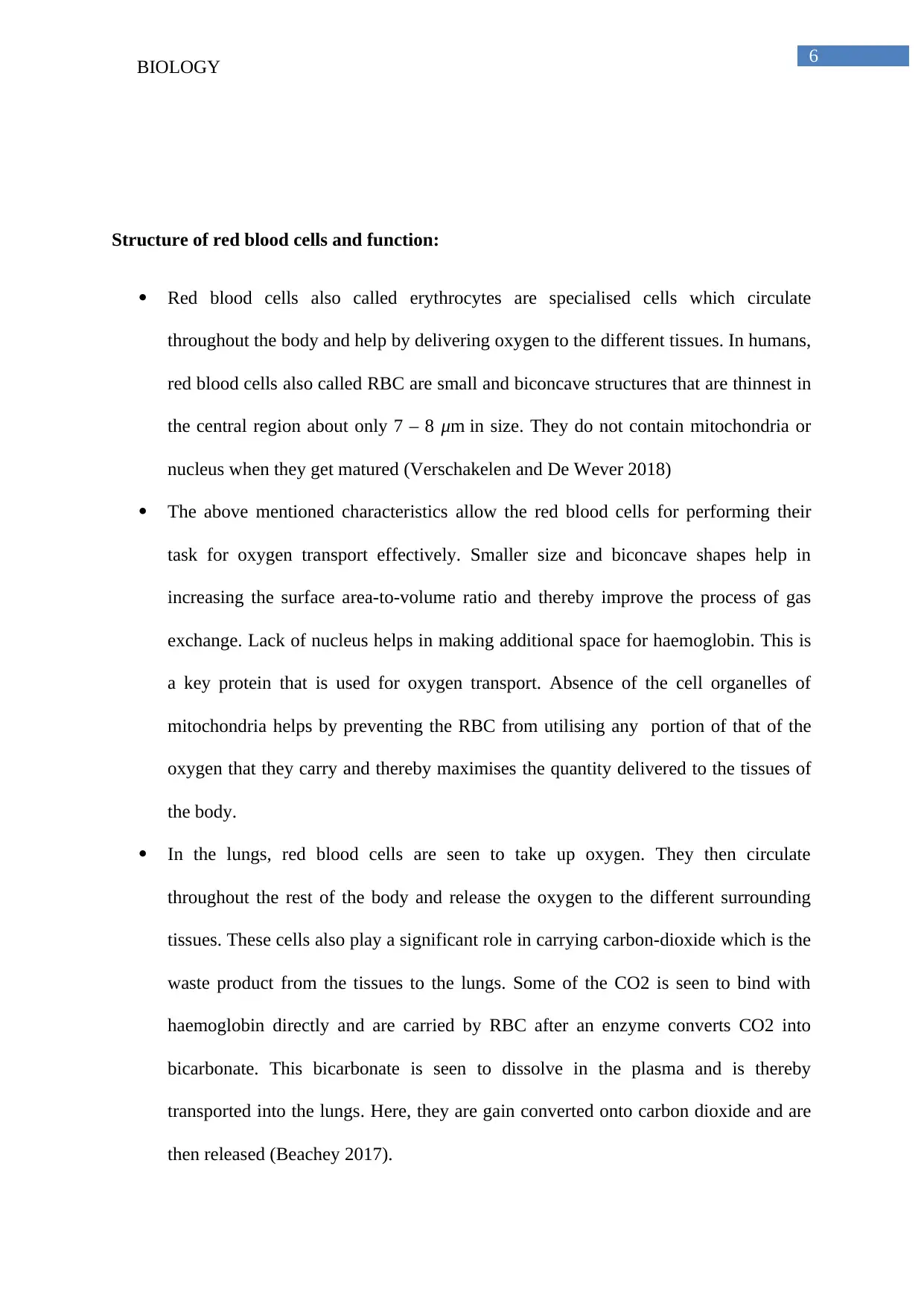
6
BIOLOGY
Structure of red blood cells and function:
Red blood cells also called erythrocytes are specialised cells which circulate
throughout the body and help by delivering oxygen to the different tissues. In humans,
red blood cells also called RBC are small and biconcave structures that are thinnest in
the central region about only 7 – 8 μm in size. They do not contain mitochondria or
nucleus when they get matured (Verschakelen and De Wever 2018)
The above mentioned characteristics allow the red blood cells for performing their
task for oxygen transport effectively. Smaller size and biconcave shapes help in
increasing the surface area-to-volume ratio and thereby improve the process of gas
exchange. Lack of nucleus helps in making additional space for haemoglobin. This is
a key protein that is used for oxygen transport. Absence of the cell organelles of
mitochondria helps by preventing the RBC from utilising any portion of that of the
oxygen that they carry and thereby maximises the quantity delivered to the tissues of
the body.
In the lungs, red blood cells are seen to take up oxygen. They then circulate
throughout the rest of the body and release the oxygen to the different surrounding
tissues. These cells also play a significant role in carrying carbon-dioxide which is the
waste product from the tissues to the lungs. Some of the CO2 is seen to bind with
haemoglobin directly and are carried by RBC after an enzyme converts CO2 into
bicarbonate. This bicarbonate is seen to dissolve in the plasma and is thereby
transported into the lungs. Here, they are gain converted onto carbon dioxide and are
then released (Beachey 2017).
BIOLOGY
Structure of red blood cells and function:
Red blood cells also called erythrocytes are specialised cells which circulate
throughout the body and help by delivering oxygen to the different tissues. In humans,
red blood cells also called RBC are small and biconcave structures that are thinnest in
the central region about only 7 – 8 μm in size. They do not contain mitochondria or
nucleus when they get matured (Verschakelen and De Wever 2018)
The above mentioned characteristics allow the red blood cells for performing their
task for oxygen transport effectively. Smaller size and biconcave shapes help in
increasing the surface area-to-volume ratio and thereby improve the process of gas
exchange. Lack of nucleus helps in making additional space for haemoglobin. This is
a key protein that is used for oxygen transport. Absence of the cell organelles of
mitochondria helps by preventing the RBC from utilising any portion of that of the
oxygen that they carry and thereby maximises the quantity delivered to the tissues of
the body.
In the lungs, red blood cells are seen to take up oxygen. They then circulate
throughout the rest of the body and release the oxygen to the different surrounding
tissues. These cells also play a significant role in carrying carbon-dioxide which is the
waste product from the tissues to the lungs. Some of the CO2 is seen to bind with
haemoglobin directly and are carried by RBC after an enzyme converts CO2 into
bicarbonate. This bicarbonate is seen to dissolve in the plasma and is thereby
transported into the lungs. Here, they are gain converted onto carbon dioxide and are
then released (Beachey 2017).
Paraphrase This Document
Need a fresh take? Get an instant paraphrase of this document with our AI Paraphraser

7
BIOLOGY
Fig: Structure of RBC Source: (Beachey 2017)
Process of carrying oxygen and carbon-dioxide in blood:
Oxygenated blood is seen to be travelling from the lungs through the different
pulmonary veins. It mainly tries to move towards the left side of the heart. This causes
pumping of the blood to the different other parts of the body. Oxygen deficient blood
rich is carbon dioxide is found to be returning to the right side of the heart through
two large veins, which are the superior vena cava and the inferior vena cava.
Following this, the blood is pumped through the pulmonary artery towards the lungs.
In this region, it picks up oxygen and is seen to be releasing carbon dioxide (Lavie et
al. 2015).
For supporting the exchange of the oxygen and carbon dioxide, about 5 to 8 litres of
air are needed to be brought in an out of the lungs every minute and about three tenth
of one litter of oxygen needs to be transferred from the alveoli to the blood every
minute.
Final steps during exchanging of the gas between the external environment and that of
the tissues are transporting oxygen as well as carbon-dioxide to and from the lung by
the blood. Oxygen is then found to be carried by being physically dissolved in the
blood as well as remain chemically combined with haemoglobin. Carbon dioxide is
BIOLOGY
Fig: Structure of RBC Source: (Beachey 2017)
Process of carrying oxygen and carbon-dioxide in blood:
Oxygenated blood is seen to be travelling from the lungs through the different
pulmonary veins. It mainly tries to move towards the left side of the heart. This causes
pumping of the blood to the different other parts of the body. Oxygen deficient blood
rich is carbon dioxide is found to be returning to the right side of the heart through
two large veins, which are the superior vena cava and the inferior vena cava.
Following this, the blood is pumped through the pulmonary artery towards the lungs.
In this region, it picks up oxygen and is seen to be releasing carbon dioxide (Lavie et
al. 2015).
For supporting the exchange of the oxygen and carbon dioxide, about 5 to 8 litres of
air are needed to be brought in an out of the lungs every minute and about three tenth
of one litter of oxygen needs to be transferred from the alveoli to the blood every
minute.
Final steps during exchanging of the gas between the external environment and that of
the tissues are transporting oxygen as well as carbon-dioxide to and from the lung by
the blood. Oxygen is then found to be carried by being physically dissolved in the
blood as well as remain chemically combined with haemoglobin. Carbon dioxide is

8
BIOLOGY
also carried being physically dissolved in the blood as well as being chemically
combined to that of blood proteins as carbamino compounds and also as bicarbonate
(Isgaard et al. 2015)
Oxygen is transported by being physically dissolved in blood as well as being
chemically combined to the haemoglobin in RBC. More oxygen is carried being
combined with haemoglobin than being physically dissolved in blood. Without the
presence of the haemoglobin, the cardiovascular network would not be able to
participate in supplying sufficient oxygen for meeting the demands of tissues (Anand
et al. 2015).
Fig: transport of gases through blood Source: (Anand et al. 2015).
Circulation of blood:
Structure of arteries, veins and capillaries and their function:
BIOLOGY
also carried being physically dissolved in the blood as well as being chemically
combined to that of blood proteins as carbamino compounds and also as bicarbonate
(Isgaard et al. 2015)
Oxygen is transported by being physically dissolved in blood as well as being
chemically combined to the haemoglobin in RBC. More oxygen is carried being
combined with haemoglobin than being physically dissolved in blood. Without the
presence of the haemoglobin, the cardiovascular network would not be able to
participate in supplying sufficient oxygen for meeting the demands of tissues (Anand
et al. 2015).
Fig: transport of gases through blood Source: (Anand et al. 2015).
Circulation of blood:
Structure of arteries, veins and capillaries and their function:

9
BIOLOGY
Artery:
The walls of the artery are seen to be comprising of three important layers. The
innermost layer is called the tunica intima or tunica interna. It is composed of simple
squamous epithelium and remains surrounded by connective tissue basement
membrane with elastic fibres. The middle layer is tunica media and is primarily
smooth muscle and is the thickest. The outermost layer is the tunica adventitia or the
tunica externa. This is a connective tissue layer and has different amounts of elastic
and collagenous fibres (Gamperl et al. 2017)..
Arteries carry blood away from the heart. Pulmonary artery carries blood low oxygen
containing blood from right ventricle to lungs. Systemic arteries carry oxygenated
blood from left ventricles to body tissues. Blood gets pumped from ventricles into
large elastic arteries which then branches in microscopic arteries called arterioles.
These play important role in regulating blood flow in capillary tissues
Fig: structure of artery; Source: (Gamperl et al. 2017).
Capillaries:
These are the smallest and most numerous of the blood vessels and form connection
between arteries and the veins. Their primary function is exchanging materials
between the blood as well as the tissue cells. Capillary distributions vary with the
BIOLOGY
Artery:
The walls of the artery are seen to be comprising of three important layers. The
innermost layer is called the tunica intima or tunica interna. It is composed of simple
squamous epithelium and remains surrounded by connective tissue basement
membrane with elastic fibres. The middle layer is tunica media and is primarily
smooth muscle and is the thickest. The outermost layer is the tunica adventitia or the
tunica externa. This is a connective tissue layer and has different amounts of elastic
and collagenous fibres (Gamperl et al. 2017)..
Arteries carry blood away from the heart. Pulmonary artery carries blood low oxygen
containing blood from right ventricle to lungs. Systemic arteries carry oxygenated
blood from left ventricles to body tissues. Blood gets pumped from ventricles into
large elastic arteries which then branches in microscopic arteries called arterioles.
These play important role in regulating blood flow in capillary tissues
Fig: structure of artery; Source: (Gamperl et al. 2017).
Capillaries:
These are the smallest and most numerous of the blood vessels and form connection
between arteries and the veins. Their primary function is exchanging materials
between the blood as well as the tissue cells. Capillary distributions vary with the
Secure Best Marks with AI Grader
Need help grading? Try our AI Grader for instant feedback on your assignments.
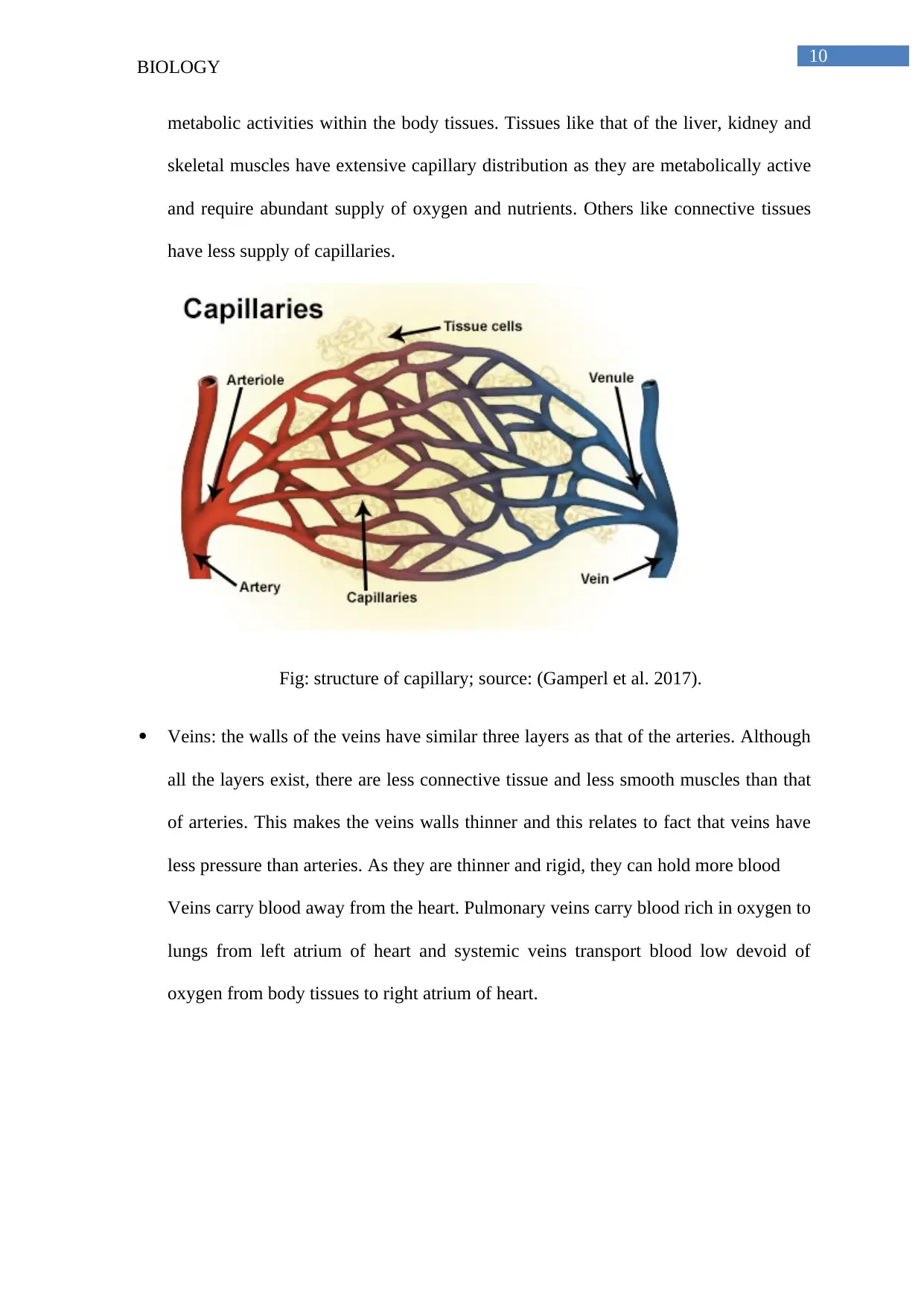
10
BIOLOGY
metabolic activities within the body tissues. Tissues like that of the liver, kidney and
skeletal muscles have extensive capillary distribution as they are metabolically active
and require abundant supply of oxygen and nutrients. Others like connective tissues
have less supply of capillaries.
Fig: structure of capillary; source: (Gamperl et al. 2017).
Veins: the walls of the veins have similar three layers as that of the arteries. Although
all the layers exist, there are less connective tissue and less smooth muscles than that
of arteries. This makes the veins walls thinner and this relates to fact that veins have
less pressure than arteries. As they are thinner and rigid, they can hold more blood
Veins carry blood away from the heart. Pulmonary veins carry blood rich in oxygen to
lungs from left atrium of heart and systemic veins transport blood low devoid of
oxygen from body tissues to right atrium of heart.
BIOLOGY
metabolic activities within the body tissues. Tissues like that of the liver, kidney and
skeletal muscles have extensive capillary distribution as they are metabolically active
and require abundant supply of oxygen and nutrients. Others like connective tissues
have less supply of capillaries.
Fig: structure of capillary; source: (Gamperl et al. 2017).
Veins: the walls of the veins have similar three layers as that of the arteries. Although
all the layers exist, there are less connective tissue and less smooth muscles than that
of arteries. This makes the veins walls thinner and this relates to fact that veins have
less pressure than arteries. As they are thinner and rigid, they can hold more blood
Veins carry blood away from the heart. Pulmonary veins carry blood rich in oxygen to
lungs from left atrium of heart and systemic veins transport blood low devoid of
oxygen from body tissues to right atrium of heart.

11
BIOLOGY
Fig: structure of vein; source: (Gamperl et al. 2017)
Structure of heart:
The human heart is comprised of four chambers and is a muscular organ that is
shaped and sized like that of the human’s closed fist and two third of the mass is
present to the left of the midline.
It is enclosed in pericardial sac like structure that remains lined with parietal layers of
the serous membrane. The visceral layer of the serous membrane is responsible for the
formation of the epicardium. Three layers of tissue form the heart wall. The outer
layer of the heart wall is the epicardium with the middle layer being the myocardium
and the inner layer being the endocardium.
The internal cavity of heart consists of two atrium - the right and left atrium. They are
thin walled chambers and receive blood from veins. The two ventricles are right and
left ventricles which are thick walled chambers forcefully pumping blood out of heart
Valve present between the right atrial and ventricular chambers are right atrio-
ventricular valve or the tricuspid valve with three cusps. Similar present is the left
atrio-ventricular valve called the mitral or bicuspid valve with two cusps. They
prevent backflow of blood. Pulmonary semi-lunar valve is present between right
BIOLOGY
Fig: structure of vein; source: (Gamperl et al. 2017)
Structure of heart:
The human heart is comprised of four chambers and is a muscular organ that is
shaped and sized like that of the human’s closed fist and two third of the mass is
present to the left of the midline.
It is enclosed in pericardial sac like structure that remains lined with parietal layers of
the serous membrane. The visceral layer of the serous membrane is responsible for the
formation of the epicardium. Three layers of tissue form the heart wall. The outer
layer of the heart wall is the epicardium with the middle layer being the myocardium
and the inner layer being the endocardium.
The internal cavity of heart consists of two atrium - the right and left atrium. They are
thin walled chambers and receive blood from veins. The two ventricles are right and
left ventricles which are thick walled chambers forcefully pumping blood out of heart
Valve present between the right atrial and ventricular chambers are right atrio-
ventricular valve or the tricuspid valve with three cusps. Similar present is the left
atrio-ventricular valve called the mitral or bicuspid valve with two cusps. They
prevent backflow of blood. Pulmonary semi-lunar valve is present between right
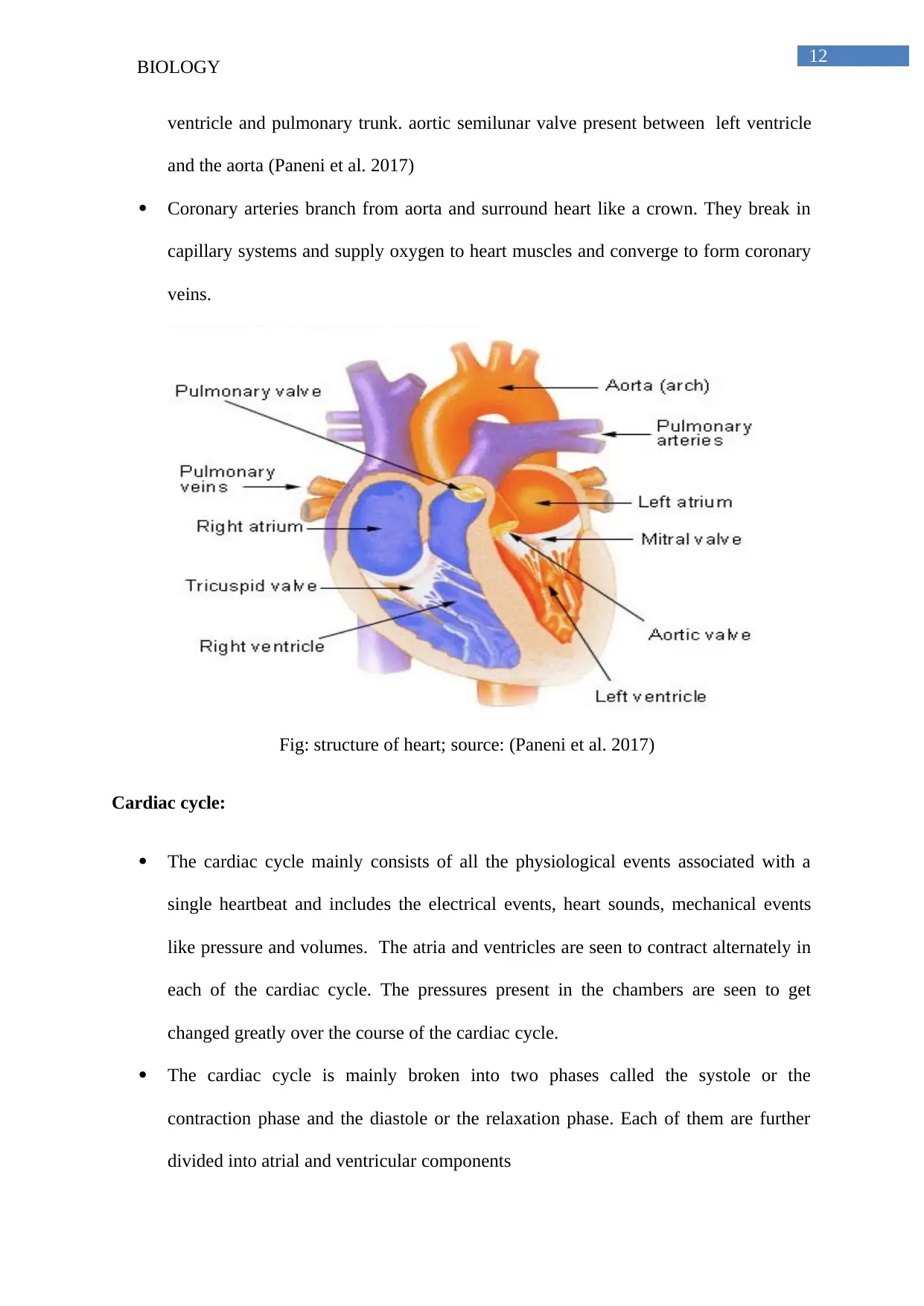
12
BIOLOGY
ventricle and pulmonary trunk. aortic semilunar valve present between left ventricle
and the aorta (Paneni et al. 2017)
Coronary arteries branch from aorta and surround heart like a crown. They break in
capillary systems and supply oxygen to heart muscles and converge to form coronary
veins.
Fig: structure of heart; source: (Paneni et al. 2017)
Cardiac cycle:
The cardiac cycle mainly consists of all the physiological events associated with a
single heartbeat and includes the electrical events, heart sounds, mechanical events
like pressure and volumes. The atria and ventricles are seen to contract alternately in
each of the cardiac cycle. The pressures present in the chambers are seen to get
changed greatly over the course of the cardiac cycle.
The cardiac cycle is mainly broken into two phases called the systole or the
contraction phase and the diastole or the relaxation phase. Each of them are further
divided into atrial and ventricular components
BIOLOGY
ventricle and pulmonary trunk. aortic semilunar valve present between left ventricle
and the aorta (Paneni et al. 2017)
Coronary arteries branch from aorta and surround heart like a crown. They break in
capillary systems and supply oxygen to heart muscles and converge to form coronary
veins.
Fig: structure of heart; source: (Paneni et al. 2017)
Cardiac cycle:
The cardiac cycle mainly consists of all the physiological events associated with a
single heartbeat and includes the electrical events, heart sounds, mechanical events
like pressure and volumes. The atria and ventricles are seen to contract alternately in
each of the cardiac cycle. The pressures present in the chambers are seen to get
changed greatly over the course of the cardiac cycle.
The cardiac cycle is mainly broken into two phases called the systole or the
contraction phase and the diastole or the relaxation phase. Each of them are further
divided into atrial and ventricular components
Paraphrase This Document
Need a fresh take? Get an instant paraphrase of this document with our AI Paraphraser
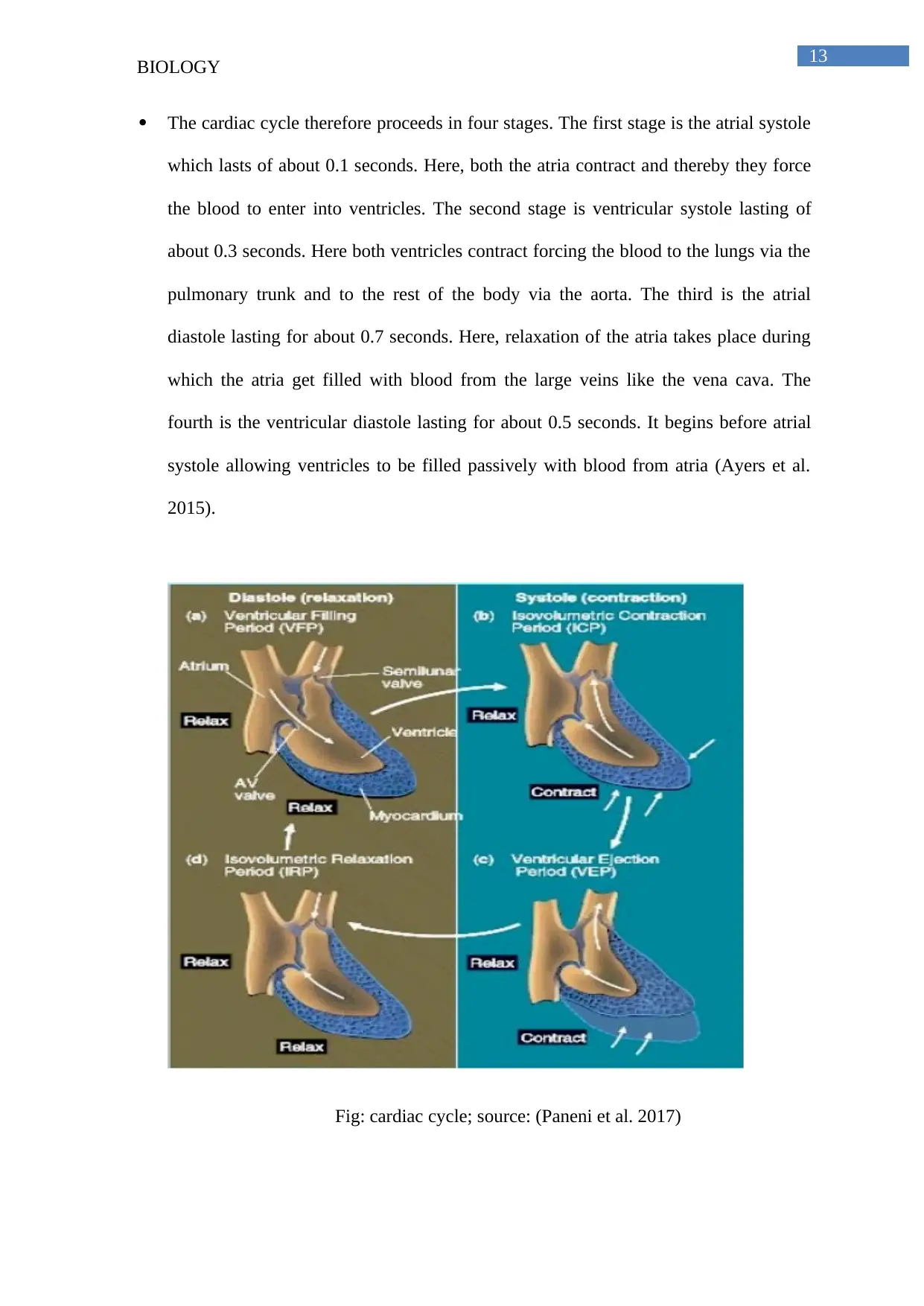
13
BIOLOGY
The cardiac cycle therefore proceeds in four stages. The first stage is the atrial systole
which lasts of about 0.1 seconds. Here, both the atria contract and thereby they force
the blood to enter into ventricles. The second stage is ventricular systole lasting of
about 0.3 seconds. Here both ventricles contract forcing the blood to the lungs via the
pulmonary trunk and to the rest of the body via the aorta. The third is the atrial
diastole lasting for about 0.7 seconds. Here, relaxation of the atria takes place during
which the atria get filled with blood from the large veins like the vena cava. The
fourth is the ventricular diastole lasting for about 0.5 seconds. It begins before atrial
systole allowing ventricles to be filled passively with blood from atria (Ayers et al.
2015).
Fig: cardiac cycle; source: (Paneni et al. 2017)
BIOLOGY
The cardiac cycle therefore proceeds in four stages. The first stage is the atrial systole
which lasts of about 0.1 seconds. Here, both the atria contract and thereby they force
the blood to enter into ventricles. The second stage is ventricular systole lasting of
about 0.3 seconds. Here both ventricles contract forcing the blood to the lungs via the
pulmonary trunk and to the rest of the body via the aorta. The third is the atrial
diastole lasting for about 0.7 seconds. Here, relaxation of the atria takes place during
which the atria get filled with blood from the large veins like the vena cava. The
fourth is the ventricular diastole lasting for about 0.5 seconds. It begins before atrial
systole allowing ventricles to be filled passively with blood from atria (Ayers et al.
2015).
Fig: cardiac cycle; source: (Paneni et al. 2017)
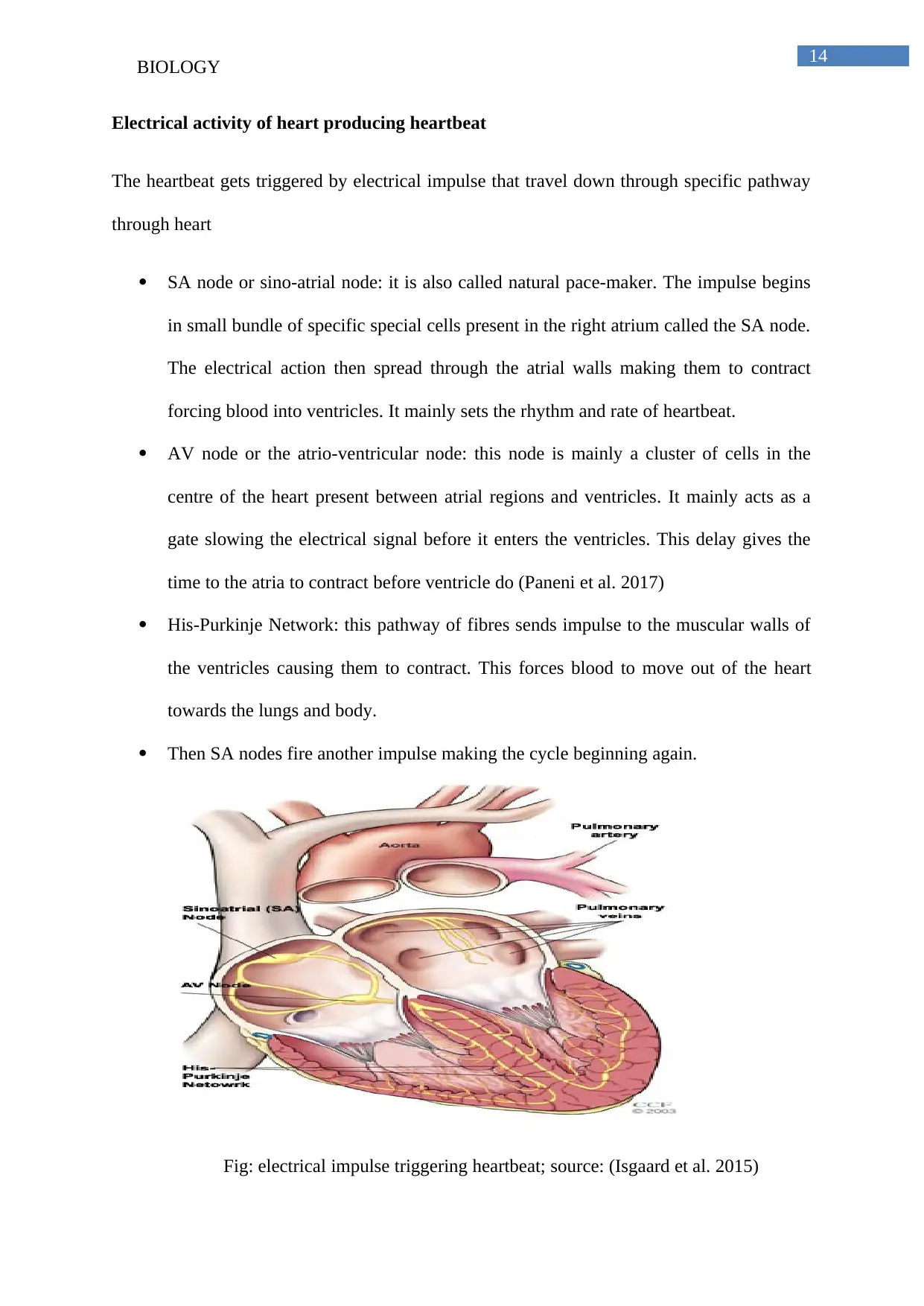
14
BIOLOGY
Electrical activity of heart producing heartbeat
The heartbeat gets triggered by electrical impulse that travel down through specific pathway
through heart
SA node or sino-atrial node: it is also called natural pace-maker. The impulse begins
in small bundle of specific special cells present in the right atrium called the SA node.
The electrical action then spread through the atrial walls making them to contract
forcing blood into ventricles. It mainly sets the rhythm and rate of heartbeat.
AV node or the atrio-ventricular node: this node is mainly a cluster of cells in the
centre of the heart present between atrial regions and ventricles. It mainly acts as a
gate slowing the electrical signal before it enters the ventricles. This delay gives the
time to the atria to contract before ventricle do (Paneni et al. 2017)
His-Purkinje Network: this pathway of fibres sends impulse to the muscular walls of
the ventricles causing them to contract. This forces blood to move out of the heart
towards the lungs and body.
Then SA nodes fire another impulse making the cycle beginning again.
Fig: electrical impulse triggering heartbeat; source: (Isgaard et al. 2015)
BIOLOGY
Electrical activity of heart producing heartbeat
The heartbeat gets triggered by electrical impulse that travel down through specific pathway
through heart
SA node or sino-atrial node: it is also called natural pace-maker. The impulse begins
in small bundle of specific special cells present in the right atrium called the SA node.
The electrical action then spread through the atrial walls making them to contract
forcing blood into ventricles. It mainly sets the rhythm and rate of heartbeat.
AV node or the atrio-ventricular node: this node is mainly a cluster of cells in the
centre of the heart present between atrial regions and ventricles. It mainly acts as a
gate slowing the electrical signal before it enters the ventricles. This delay gives the
time to the atria to contract before ventricle do (Paneni et al. 2017)
His-Purkinje Network: this pathway of fibres sends impulse to the muscular walls of
the ventricles causing them to contract. This forces blood to move out of the heart
towards the lungs and body.
Then SA nodes fire another impulse making the cycle beginning again.
Fig: electrical impulse triggering heartbeat; source: (Isgaard et al. 2015)

15
BIOLOGY
Calculation of cardiac output and its importance:
The cardiac output is simply the amount of blood that gets pumped by the heart in one
minute. It can be calculated by multiplying the heart rate (HR = number of beats per
minute) with the stroke volume (SV = amount pumped per beat)
CO = HR X SV
Cardiac output acts as primary determinant of global oxygen transport from the heart
to the different parts of the body. The major function of the cardiovascular system is
proper supplying of sufficient amounts of oxygen for meeting the metabolic needs of
the tissues. Therefore, it seems reasonable for measuring cardiac output for the
assessment of cardiovascular insufficiency (Isgaard et al. 2015).
BIOLOGY
Calculation of cardiac output and its importance:
The cardiac output is simply the amount of blood that gets pumped by the heart in one
minute. It can be calculated by multiplying the heart rate (HR = number of beats per
minute) with the stroke volume (SV = amount pumped per beat)
CO = HR X SV
Cardiac output acts as primary determinant of global oxygen transport from the heart
to the different parts of the body. The major function of the cardiovascular system is
proper supplying of sufficient amounts of oxygen for meeting the metabolic needs of
the tissues. Therefore, it seems reasonable for measuring cardiac output for the
assessment of cardiovascular insufficiency (Isgaard et al. 2015).
Secure Best Marks with AI Grader
Need help grading? Try our AI Grader for instant feedback on your assignments.
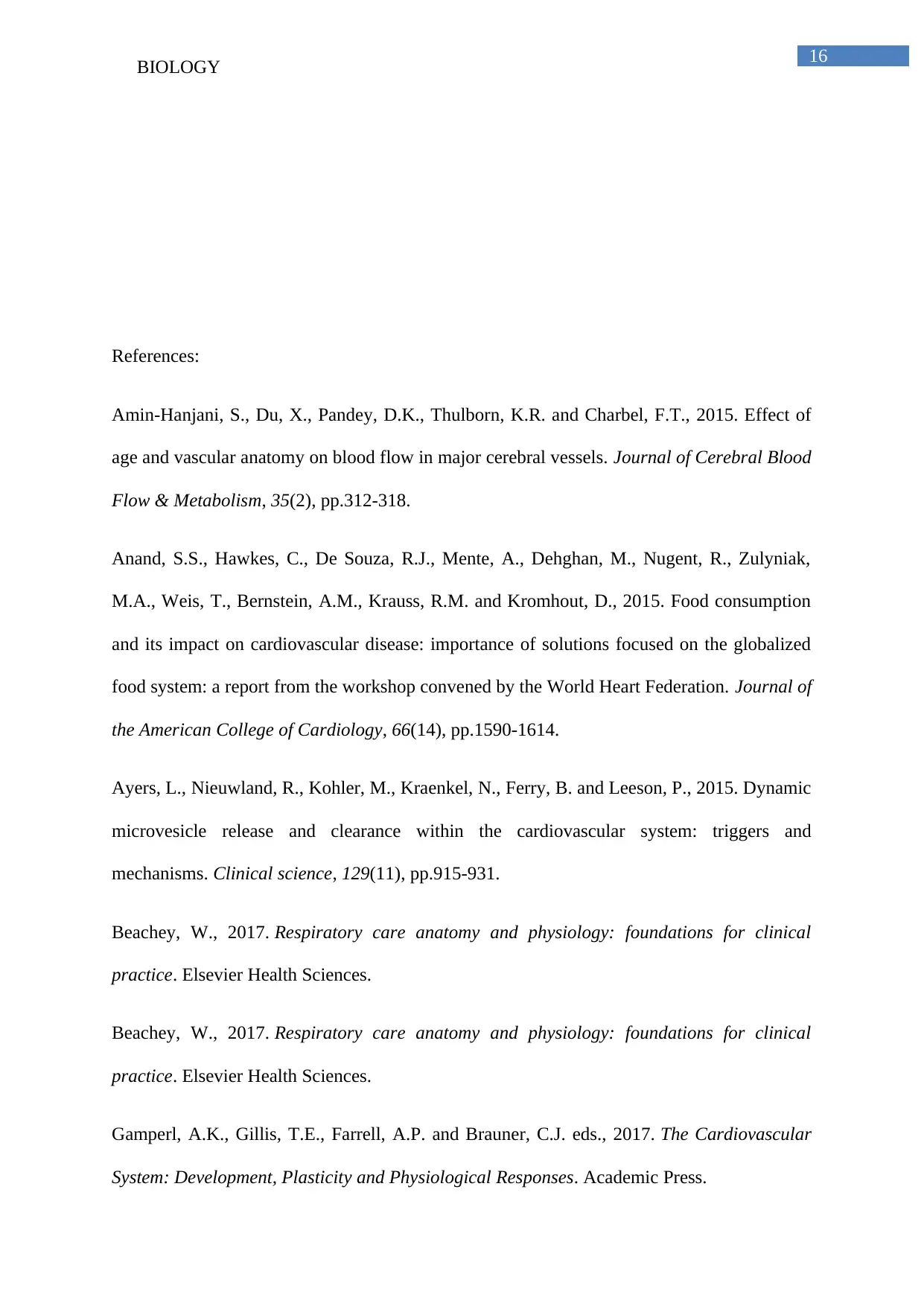
16
BIOLOGY
References:
Amin-Hanjani, S., Du, X., Pandey, D.K., Thulborn, K.R. and Charbel, F.T., 2015. Effect of
age and vascular anatomy on blood flow in major cerebral vessels. Journal of Cerebral Blood
Flow & Metabolism, 35(2), pp.312-318.
Anand, S.S., Hawkes, C., De Souza, R.J., Mente, A., Dehghan, M., Nugent, R., Zulyniak,
M.A., Weis, T., Bernstein, A.M., Krauss, R.M. and Kromhout, D., 2015. Food consumption
and its impact on cardiovascular disease: importance of solutions focused on the globalized
food system: a report from the workshop convened by the World Heart Federation. Journal of
the American College of Cardiology, 66(14), pp.1590-1614.
Ayers, L., Nieuwland, R., Kohler, M., Kraenkel, N., Ferry, B. and Leeson, P., 2015. Dynamic
microvesicle release and clearance within the cardiovascular system: triggers and
mechanisms. Clinical science, 129(11), pp.915-931.
Beachey, W., 2017. Respiratory care anatomy and physiology: foundations for clinical
practice. Elsevier Health Sciences.
Beachey, W., 2017. Respiratory care anatomy and physiology: foundations for clinical
practice. Elsevier Health Sciences.
Gamperl, A.K., Gillis, T.E., Farrell, A.P. and Brauner, C.J. eds., 2017. The Cardiovascular
System: Development, Plasticity and Physiological Responses. Academic Press.
BIOLOGY
References:
Amin-Hanjani, S., Du, X., Pandey, D.K., Thulborn, K.R. and Charbel, F.T., 2015. Effect of
age and vascular anatomy on blood flow in major cerebral vessels. Journal of Cerebral Blood
Flow & Metabolism, 35(2), pp.312-318.
Anand, S.S., Hawkes, C., De Souza, R.J., Mente, A., Dehghan, M., Nugent, R., Zulyniak,
M.A., Weis, T., Bernstein, A.M., Krauss, R.M. and Kromhout, D., 2015. Food consumption
and its impact on cardiovascular disease: importance of solutions focused on the globalized
food system: a report from the workshop convened by the World Heart Federation. Journal of
the American College of Cardiology, 66(14), pp.1590-1614.
Ayers, L., Nieuwland, R., Kohler, M., Kraenkel, N., Ferry, B. and Leeson, P., 2015. Dynamic
microvesicle release and clearance within the cardiovascular system: triggers and
mechanisms. Clinical science, 129(11), pp.915-931.
Beachey, W., 2017. Respiratory care anatomy and physiology: foundations for clinical
practice. Elsevier Health Sciences.
Beachey, W., 2017. Respiratory care anatomy and physiology: foundations for clinical
practice. Elsevier Health Sciences.
Gamperl, A.K., Gillis, T.E., Farrell, A.P. and Brauner, C.J. eds., 2017. The Cardiovascular
System: Development, Plasticity and Physiological Responses. Academic Press.

17
BIOLOGY
Ghersi-Egea, J.F., Strazielle, N., Catala, M., Silva-Vargas, V., Doetsch, F. and Engelhardt,
B., 2018. Molecular anatomy and functions of the choroidal blood-cerebrospinal fluid barrier
in health and disease. Acta neuropathologica, pp.1-25.
Hansen, J.T., 2017. Netter's Clinical Anatomy E-Book. Elsevier Health Sciences.
Isgaard, J., Arcopinto, M., Karason, K. and Cittadini, A., 2015. GH and the cardiovascular
system: an update on a topic at heart. Endocrine, 48(1), pp.25-35.
Lavie, C.J., Arena, R., Swift, D.L., Johannsen, N.M., Sui, X., Lee, D.C., Earnest, C.P.,
Church, T.S., O’keefe, J.H., Milani, R.V. and Blair, S.N., 2015. Exercise and the
cardiovascular system: clinical science and cardiovascular outcomes. Circulation
research, 117(2), pp.207-219.
Paneni, F., Cañestro, C.D., Libby, P., Lüscher, T.F. and Camici, G.G., 2017. The aging
cardiovascular system: understanding it at the cellular and clinical levels. Journal of the
American College of Cardiology, 69(15), pp.1952-1967.
Protti, A., Andreis, D.T., Milesi, M., Iapichino, G.E., Monti, M., Comini, B., Pugni, P.,
Melis, V., Santini, A., Dondossola, D. and Gatti, S., 2015. Lung anatomy, energy load, and
ventilator-induced lung injury. Intensive care medicine experimental, 3(1), p.34.
Rizzo, D.C., 2015. Fundamentals of anatomy and physiology. Cengage Learning.
Scanlon, V.C. and Sanders, T., 2018. Essentials of anatomy and physiology. FA Davis.
Serlin, Y., Shelef, I., Knyazer, B. and Friedman, A., 2015, February. Anatomy and
physiology of the blood–brain barrier. In Seminars in cell & developmental biology (Vol. 38,
pp. 2-6). Academic Press.
BIOLOGY
Ghersi-Egea, J.F., Strazielle, N., Catala, M., Silva-Vargas, V., Doetsch, F. and Engelhardt,
B., 2018. Molecular anatomy and functions of the choroidal blood-cerebrospinal fluid barrier
in health and disease. Acta neuropathologica, pp.1-25.
Hansen, J.T., 2017. Netter's Clinical Anatomy E-Book. Elsevier Health Sciences.
Isgaard, J., Arcopinto, M., Karason, K. and Cittadini, A., 2015. GH and the cardiovascular
system: an update on a topic at heart. Endocrine, 48(1), pp.25-35.
Lavie, C.J., Arena, R., Swift, D.L., Johannsen, N.M., Sui, X., Lee, D.C., Earnest, C.P.,
Church, T.S., O’keefe, J.H., Milani, R.V. and Blair, S.N., 2015. Exercise and the
cardiovascular system: clinical science and cardiovascular outcomes. Circulation
research, 117(2), pp.207-219.
Paneni, F., Cañestro, C.D., Libby, P., Lüscher, T.F. and Camici, G.G., 2017. The aging
cardiovascular system: understanding it at the cellular and clinical levels. Journal of the
American College of Cardiology, 69(15), pp.1952-1967.
Protti, A., Andreis, D.T., Milesi, M., Iapichino, G.E., Monti, M., Comini, B., Pugni, P.,
Melis, V., Santini, A., Dondossola, D. and Gatti, S., 2015. Lung anatomy, energy load, and
ventilator-induced lung injury. Intensive care medicine experimental, 3(1), p.34.
Rizzo, D.C., 2015. Fundamentals of anatomy and physiology. Cengage Learning.
Scanlon, V.C. and Sanders, T., 2018. Essentials of anatomy and physiology. FA Davis.
Serlin, Y., Shelef, I., Knyazer, B. and Friedman, A., 2015, February. Anatomy and
physiology of the blood–brain barrier. In Seminars in cell & developmental biology (Vol. 38,
pp. 2-6). Academic Press.
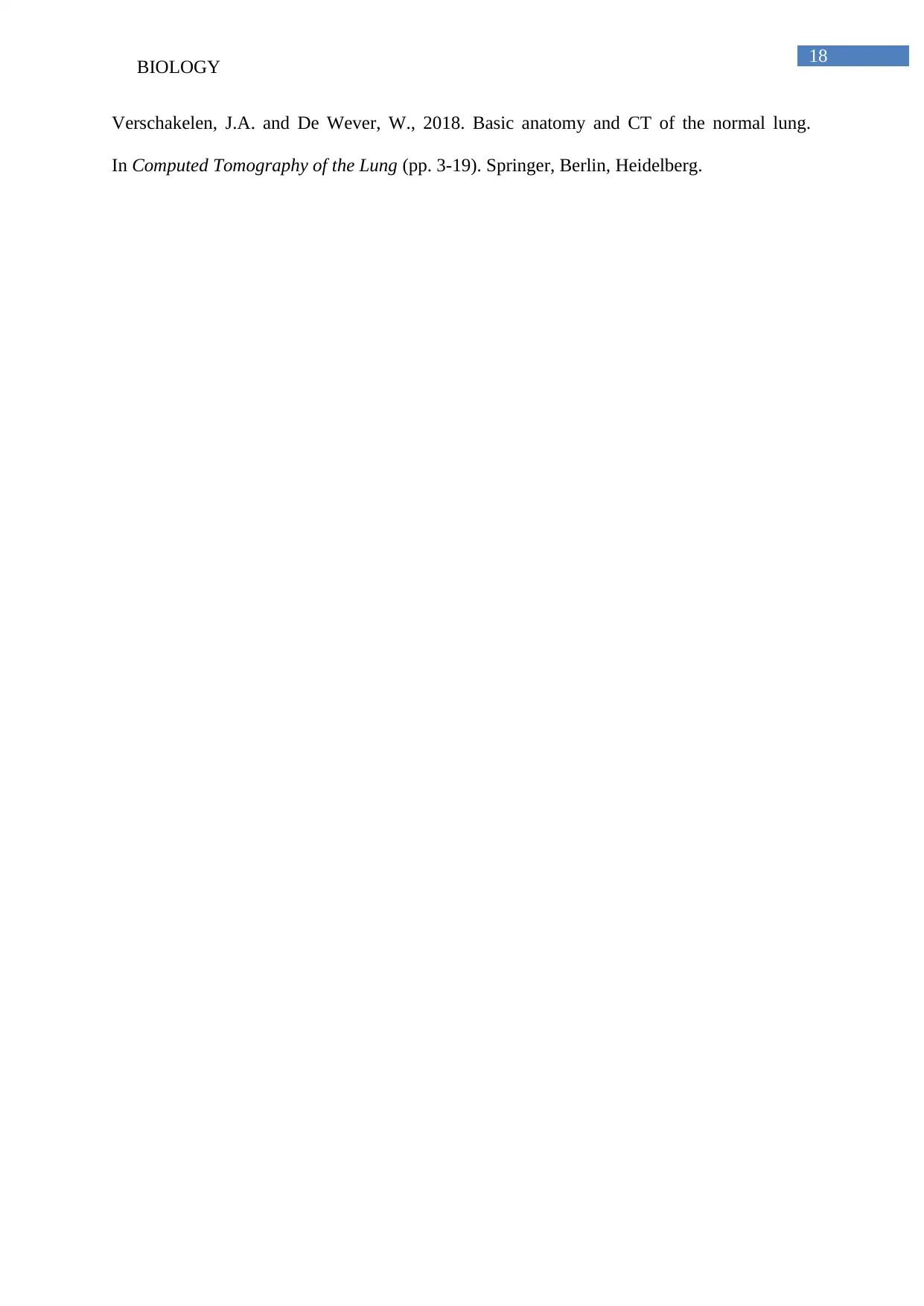
18
BIOLOGY
Verschakelen, J.A. and De Wever, W., 2018. Basic anatomy and CT of the normal lung.
In Computed Tomography of the Lung (pp. 3-19). Springer, Berlin, Heidelberg.
BIOLOGY
Verschakelen, J.A. and De Wever, W., 2018. Basic anatomy and CT of the normal lung.
In Computed Tomography of the Lung (pp. 3-19). Springer, Berlin, Heidelberg.
1 out of 19
Related Documents
Your All-in-One AI-Powered Toolkit for Academic Success.
+13062052269
info@desklib.com
Available 24*7 on WhatsApp / Email
![[object Object]](/_next/static/media/star-bottom.7253800d.svg)
Unlock your academic potential
© 2024 | Zucol Services PVT LTD | All rights reserved.





